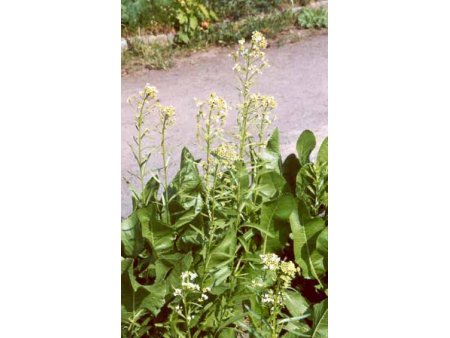
2005 Year in Review
Back to Page two: Recreation & Adult Education Listing | Back to Year in Review Index
A Little Dab of Horseradish Could Help Resist Cancer |
|
A new study from the University of Illinois shows that horseradish has substantial quantities of glucosinolates, compounds that has been shown to increase human resistance to cancer. "Glucosinolates increase the liver's ability to detoxify carcinogens and they may actually suppress the growth of existing cancerous tumors," said Mosbah Kushad, U of I associate professor of food-crop systems. "And our analysis of various horseradish varieties shows they are a rich source of these compounds." Kushad has also been involved in studies of broccoli, Brussels sprouts and other cruciferous vegetables known to contain glucosinolates. His work shows that horseradish has relatively higher levels. "Horseradish contains more than 10-fold higher glucosinolates than broccoli, so you donít need much horseradish to benefit. In fact, a little dab on your steak will go a long way to providing the same health benefits as broccoli." An effective dose of broccoli may be as little as 10 grams a day, so an effective dose of horseradish could be as little as 1 gram or less than a teaspoon. Kushad has tested more than 27 accessions of horseradish and detected eight different glucosinolates in both the root and leaf tissue. He noted that the health benefit of horseradish is improved by processing. "Horseradish also contains an enzyme that breaks down glucosinolates into the compounds that produce the anti-cancer benefits. So processing horseradish actually helps. It releases this enzyme and, when it comes into contact with the glucosinolates, they break down into the compounds that are nutritionally beneficial," he said. There are four popular, commercial varieties grown in Illinois. Two have about 50 percent more glucosinolates than the other two. The most widely accepted hypothesis for the physiological function of glucosinolates in horseradish plants is that they somehow help the plant defend itself against several pests. So breeding studies that accentuate glucosinolate levels could enhance pest resistance as well as create human health benefits. Horseradish is an important crop in Illinois. Sixty percent of all horseradish produced in the United States is grown in Illinois. Most of the crop is crushed and mixed into relishes and sauces. The University of Illinois maintains a germplasm collection totaling 130 horseradish accessions with geographic origins from Eastern Europe and North America. This research was published in the October 2004 Journal of Agriculture and Food Chemistry and was funded, in part, by the Illinois Horseradish Grower's Association. by Editor, theCity1.com |
|
Copyright © 2005 TheCity1.com.
All rights reserved
